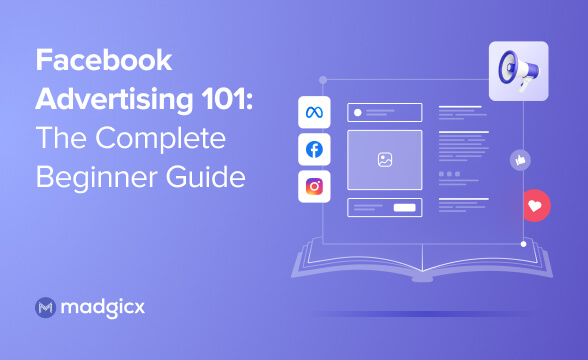Creative testing can make or break your Facebook ad ROI. Learn how to plan, manage, analyze, and optimize your Facebook A/B tests with this complete guide.
Creative testing is one of the most powerful experiments you can run with your Facebook ads.
If you aren’t doing it already, you’re leaving money on the table.
In this article, we'll cover everything you need to know about creative testing—what it is, how to create and manage it, and how to analyze your results.
Creative testing 101
If you're not familiar with the term, Facebook ad creative testing is a way to determine which version of your ad resonates best with your target audience, thus earning you the most revenue.
This involves creating several versions of your ad with different images, copy, and headlines, then running them against each other to see which performs better.
The idea is that by testing multiple variations of your ad, you can identify which elements are working and which ones aren't. This information can then be used to optimize your ad to get the best possible results.
Overall, there are 2 main reasons why you want to routinely do some creative testing with your Facebook ads:
- Optimize ad performance. Creative testing is the best (and maybe only) way to know what your audience really likes. By continuously testing and optimizing ads, advertisers can improve their ad performance and drive better results.
- Reduce ad fatigue. Over time, the same ad creative can become repetitive and lose its impact, costing you dearly in the process. By testing and rotating different ad creatives, advertisers can reduce ad fatigue and keep their audience engaged.
If you’re not convinced, just take a look at this example from one Madgicx eCommerce client that sells watches.
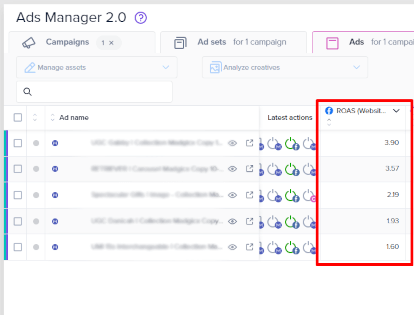
By consistently testing their creatives, they were able to achieve nearly 4x ROAS—a bragworthy achievement indeed.
Now that we've learned what creative testing is, let's dive into the juicy stuff—how to test things the right way.
How to plan your creative testing
Step 1. Define the testing hypothesis
Creative tests are often referred to as experiments—and for good reason. A well-thought-out creative test follows a similar structure as the scientific method:

First, we make observations about our campaign. One observation could be that our campaigns aren't generating as much revenue as they used to.
Next, we want to research those findings further. If, during our campaign evaluation, we find that our click-through rates are low, we might hypothesize that our creative elements need to be improved.
Once you have your hypothesis in hand, you can then move on to the rest of the steps—testing, analyzing, and finally, our conclusion.
Step 2. Establish a clear objective
The next step is to define clear objectives for your test. After all, you won't be able to know if your experiment is successful if you don't define what success looks like for you.
You'd want to consider:
- Your main goal for this campaign. Based on the funnel stage you're targeting, this could be purchases, clicks, video views, etc. This KPI will be your north-star metric.
- Your specific threshold for success. If you have baseline KPIs from prior campaigns, you can use these to determine the bare minimum results you're looking for.
Step 3. Determine the scope and budget of the test
After establishing your objective, it's time to determine the scope and budget of your test. Let's break those two down.
Determine your budget: Your budget will depend on the size of your audience, the number of ad variations you want to test, and the duration of the test. We recommend that you allocate 5%-10% of your total ad budget for testing.
Define your scope: The scope of your Facebook ad creative test will depend on the number of variations you want to test and the size of your audience. To get statistically significant results, it's recommended to test at least three ad variations per ad set.
Step 4. Identify the target audience
One of the most important parts of this process is to identify the target audience of your campaign.
The funnel stage of your audience, after all, will reflect the offer and goal of the test.
A solid targeting strategy will include a full-funnel approach, and your creative testing is no different. Before you decide what creative elements to test, first identify who it is you're targeting.
Once you determine what audience you'll be using for your tests, you can then tailor the creative components (offer, copy, graphics, etc.) to them.
Typically, you'd want to go with a top-of-the-funnel audience that will have a larger size and one that has worked well for you in the past. Having historical data on audience performance can give you your own baseline for determining the success of your creative testing and an extra layer of information for deciding when to turn a test off.
You can also analyze your previous results to see which offers/creative elements have performed well in the past (or which you should avoid) as a guide for what tests you want to run in the future.
Step 5. Select the appropriate testing method
Now after you have all of the pieces together, the final part is to select your testing method. Since we're focusing on Facebook ad creatives, our method of testing would be focused on either A/B testing or multivariate testing (more on those below).
However, you can also use things like your landing page or store pages to further test your theories. For example, if you believe highlighting free shipping is likely to increase clicks and conversions, consider featuring this on both your Facebook ad creatives as well as your landing/checkout pages.
How to run a creative test
Thus far, we've given you the strategies you need to be able to determine what you should be testing. Now we want to dive into how to actually create and manage your test.
Pick the elements you want to test
With regard to Facebook ads, there's a seemingly endless number of things you can test. On the creative side, there are a few main levers you can pull that will have a huge impact on your results.
- Messaging: The messaging in your ad refers to the language and tone used to convey your message to your target audience. Your messaging should be clear, concise, and relevant to your audience to grab their attention and encourage them to engage with your ad.
- Style: The style of your ad refers to the overall aesthetic of your ad, including colors, fonts, and imagery. Your ad style should align with your brand image and target audience preferences to increase engagement and recognition.
- Creative format: The creative format refers to the type of ad you choose to use, such as single-image, carousel, or video. Each format has its own advantages and disadvantages, and you should choose the format that best suits your goals and target audience.
- Hook: The hook is the attention-grabbing element of your ad that draws your audience in and encourages them to engage with your ad. This can be a catchy headline, a bold image, or a captivating video that piques your audience's interest.
- Call-to-action (CTA): The CTA is a clear and specific instruction that tells your audience what you want them to do after viewing your ad. This can be anything from "Shop Now" to "Sign Up Today," depending on your ad objective.
P.S.: If you're struggling with coming up with a compelling creative, you can check out our guide on Facebook ad creatives.
Decide on A/B testing or multivariate testing
A/B testing and multivariate testing are two common methods of creative testing used in Facebook ads to determine the most effective ad variations.
A/B testing involves testing different ad variations of one element against one another to determine which one performs better. You can test different things like images, ad copy, or calls-to-action (CTAs), to see which variation drives the most engagement or conversions. In this case, you would be testing different images for the creative, for example, but keeping the rest of the ad the same.
On the other hand, multivariate testing involves testing multiple ad elements simultaneously to determine which combination performs best. For example, you can test multiple ad headlines, images, and CTAs to see which combination drives the most conversions.
Multivariate testing can provide more detailed insights than A/B testing by showing how different ad elements work together to impact overall performance.
While both options will give you results, there are a few reasons to use each.
Use A/B tests when:
- You only want to test one thing at a time
- You need to get insights quickly
- You have a smaller budget for testing
Use multivariate tests when:
- You have a bigger budget and a longer time window to test
- You're looking for more advanced insights and trends
Plan budget and timing
Since we've now decided how many tests we're going to do with either the A/B or multivariate approach, we're now able to fully plan out our experiment.
As we mentioned above, running more ads means you'll need a larger budget. While how much you'll need is dependent on your audience, conversion goals, and the number of ads, you typically want to spend around 5%-10% of your total ad budget on testing.
Another thing that will definitely impact your campaign cost is your timing. As we learned from our own ad cost breakdown, seasonality has a huge impact on your advertising costs.
This means that, ideally, you'd complete your testing rounds before the costs get higher (typically in Q4 if we're going by cost per impression).
How to launch your creative test on Madgicx
We pride ourselves on being one of the top authorities on Facebook ads, so it should be no surprise that we have developed some useful tools to make creating and managing your creative testing much easier than on Facebook.
In order to launch a creative test on Madgicx, simply log in (or sign up for your 7-day free trial) and click on Creatives>Create New Ad.
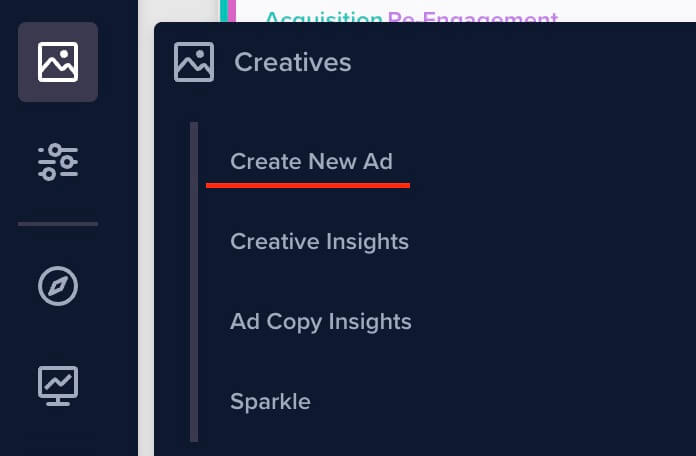
On the next page, you can start to build out your first ad by using images/video, adding headlines, etc.
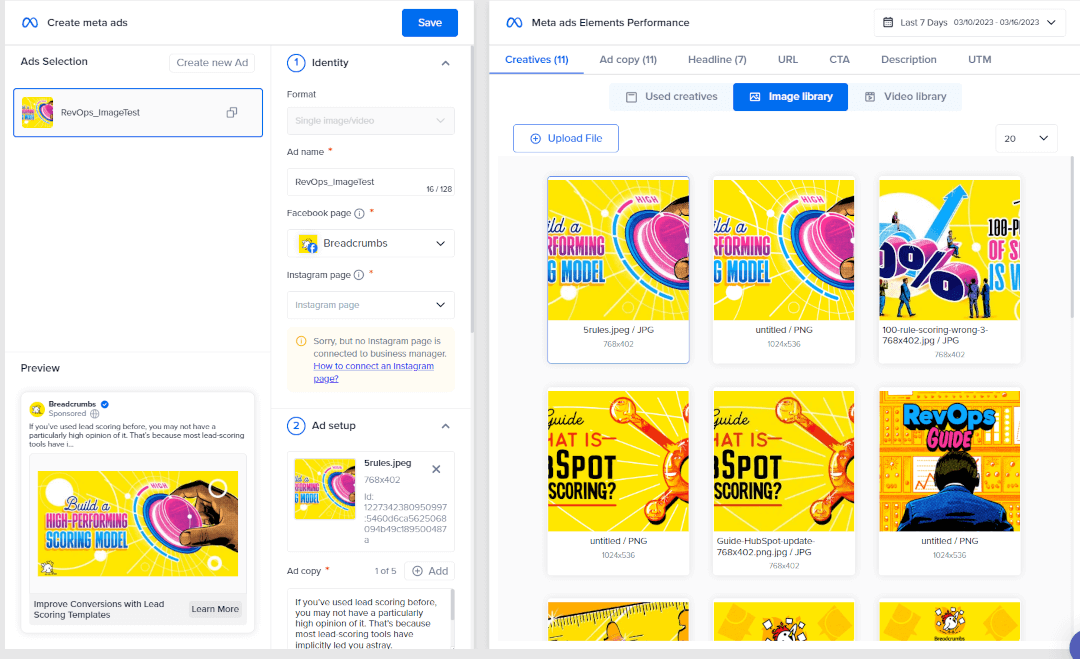
Next, you can then choose to duplicate that ad and edit the new copy for your test. You'd want to repeat this process until you have all the ads needed for your campaign.
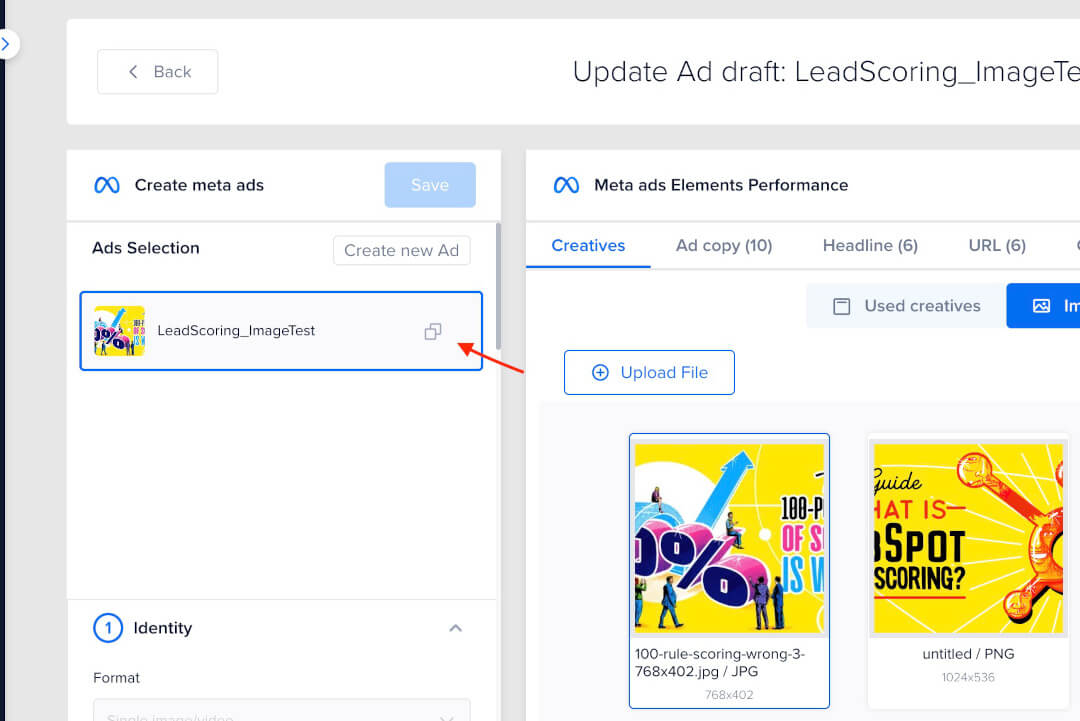
After you're finished with the creative side, you can head over to Launcher>Audience Launcher to set up the audience you want to use for these ads.
Since Audience Launcher comes with over 100+ pre-made audience segments for you to choose from, this process is pretty quick to go through. :)

In the next step, you want to create your campaign and give it a name. Then you can add your audiences and creatives to your tests.
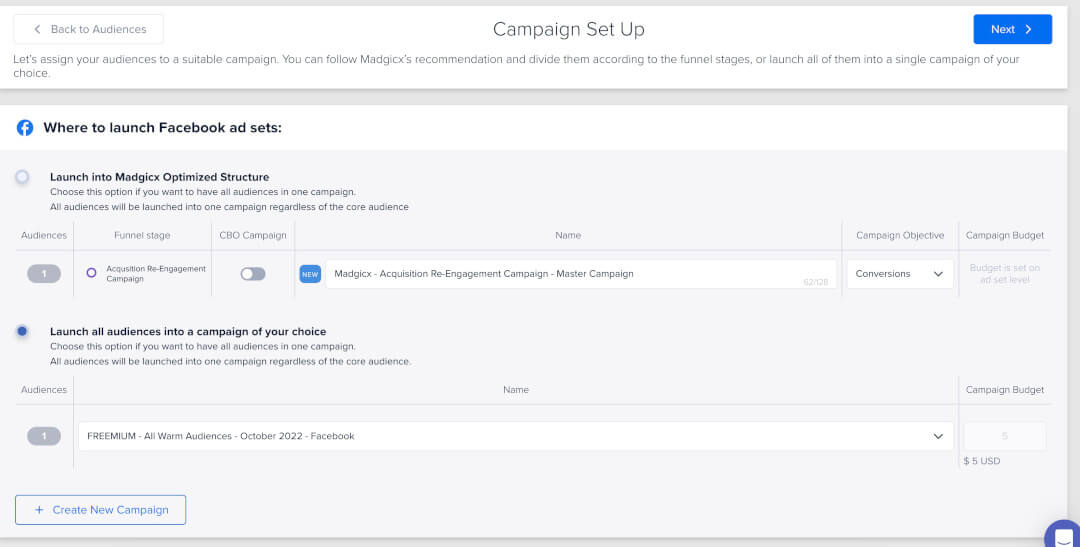
Now here's where things get a little different. Since we're creating new versions of our ads, we want to be able to firmly control the budget. Since the budget is held at the ad set level, we want to duplicate each ad set for each ad we're running.

You can make any final changes by selecting your ad sets and changing the settings at the bottom of the page. After that, you're well on your way to becoming the next Neil deGrasse Tyson of Facebook advertising. 🧪
Analyze your results
As we shake off our lab coats and readjust our goggles, we're ready to reach the end of our testing journey: reviewing the results.
Just like with the other steps, this too has its own specific process you should follow.
Collect and analyze the data
It may seem like common sense, but the first step in determining your winning creative is to sit down and take a look at the results.
You can do that one of two ways: either manually with Facebook by sorting through a dozen templates, or, taking the time to create your own tables in Excel and export them to a third-party tool to help you visualize them.
Or, you can save yourself a huge amount of time and effort and use Madgicx's Creative Insights.
One of the easiest ways to see some clear insights is by using the ad format widget to view the type of format that works best for you.

That means no more sorting through hundreds of ads with all-too-similar names trying to find which one gave you the best results. You can use this data to make sure you’re using the right format for every campaign.
Next up is the Creative Matrix.
The Creative Matrix is the best way to view your creative performance across your account at a glance.
With this scatterplot-style graph, you can easily see which creatives are the most profitable, which could be more profitable with scaling, and which are not worth your time. You can even sort your creatives by age group, gender, country, placement, and funnel stage.
Last (but certainly not least) is AI labeling.
Everyone is talking about the wonders of AI, but Madgicx has been using AI to generate time-saving insights for brands for a while. AI labeling harnesses the power of AI to find the exact creative elements and attributes that drive higher ROI for your campaigns.
These are just a few of the incredible creative features we have at Madgicx, and we urge you to give them a try during your 7-day free trial. :)
Review your success metrics
As we discussed earlier, you should always define what success looks like to you before you start your campaign. When you're looking to analyze the performance, the very first step is to review all of the guiding metrics you chose in the first place.
In addition to the metrics we mentioned earlier (clicks, click-through rate, conversions, etc.), there are some other notable KPIs to view when trying to pick a winner.
- ROAS (return on ad spend)
- Engagement rate (specifically for cold audiences at the top of the funnel)
- Thumb-stop ratio - (how frequently people watched the first 3 seconds of your ad)
- Cost per purchase
- Net profit
Make sure your data is valid
In science, you shouldn't form sweeping opinions based on the data of two people. The same goes for your creative testing. Before you make the final decision, you'll likely want to check that you've achieved validity with your dataset.
While there's no one-size-fits-all number that can guarantee you success, you should look at your current north-star metrics for guidance.
For example, if you typically have 100,000 purchases in your online store each day, 100 purchases from a campaign probably aren't fully representative of the audience you're targeting.
Determine the winning creative(s)
Finally, we come to the end of the cycle—picking our winning creatives. As long as you have followed all the advice in this guide, you should find that you have one (or more) winning variations and have improved your campaign's ROI in the process.
Time to give yourself a big pat on the back!
Implement the results
There's another reason why I decided to select the scientific method image at the beginning of this article: the cycle never actually ends ;)
After you've determined the winner, there's still some more work to do as you'll need to implement your conclusions and turn them into your new ads strategy.
For the winning creatives, you should start by duplicating the winners and scaling them by launching them into additional ad sets. Before you do that, you'll want to read our complete guide to Facebook ad scaling, as it's not as easy as just throwing more money at the campaign.
For the underperformers, you should pause them so they don't take up more ad spend than they should. You can always consider retesting different aspects to see if that changes your result and start the cycle all over again.
Best practices for creative testing
When starting a completely new task, it's always easier to learn some sage advice from those who have done it before.
Here are some helpful tips and best practices for creative testing by your friends here at Madgicx:
- Test one variable at a time with A/B testing. To get accurate results, it's easiest to test one variable at a time. Testing multiple variables at once can make it challenging to determine which variable caused the changes in your ad's performance.
- Use a large enough sample size. Your sample size should be large enough to produce statistically valid results, as we mentioned above.
- Allow enough time for testing. To ensure that your results are reliable, you should allow enough time for testing. Facebook recommends running your test for seven days at least.
- Use a clear naming convention. To keep your testing organized, it's important to use a clear naming convention for your ad variations. This will help you identify which variable you're testing and make it easier to analyze the results when looking at it in a table.
- Continuously iterate and improve. Once you have your results, use them to make informed decisions about how to improve your ad. Continuously iterate and improve your ad creative based on the data you've collected to maximize your ROI.
That being said, it can be tough to create a host of images and videos, especially if you're just starting out. As always, we have an answer for you: Sparkle.
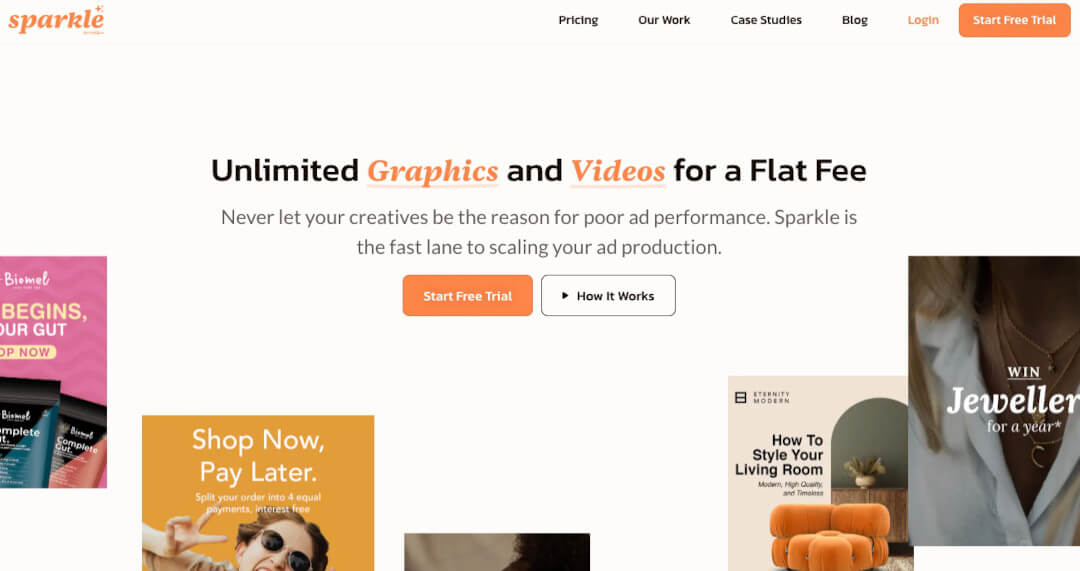
Sparkle acts as your own unlimited on-demand design team. With Sparkle, you won't have to wait for designers to return from holidays, hound freelancers for modifications, or be restricted by your in-house team's limited availability.
Simply submit your design brief to the Sparkle team, and within 48 hours, we'll deliver custom-tailored creative assets directly to your team. There are an unlimited number of revisions included, meaning we're never satisfied until you're satisfied.
You can learn more about Sparkle's unlimited flat-fee design program here.
By following these best practices, you can ensure that your Facebook ad creative testing is accurate, reliable, and effective in optimizing your ads' performance.
It's also important to note that testing doesn't stop at the creative portion. There's a whole host of other Facebook testing options available to you, like audience, objective, optimization, etc. You can follow the same general theory we mentioned today (as well as Madgicx’s app) to run those tests as well.
Conclusion
This has been a long article, I know, but now you're ready to grab your Facebook creative testing diploma and walk across the stage beaming at all your friends and family.
Or, at least, that's how I'm envisioning your newfound success ;)
To recap, we've covered just how important testing your creatives can be and showed you an example of how one customer increased their results by 2.4x by using Madgicx's creative testing features.
We’ve also shown you the exact steps you need to create and manage your test, and best practices from the testing pros to help you succeed.
In reality, there's no better time to start testing your creatives than now. When it comes to Facebook ad experiments, wasted time IS wasted money.
Save HOURS of work and see how much easier it is to launch effective, data-driven creative testing campaigns using Madgicx (v.s. the Ads Manager). Even better? You'll get to analyze and optimize your results infinitely faster.
Tory is a digital marketing specialist and the current Marketing Manager of Breadcrumbs.io. She's been featured in various high-profile marketing blogs like Hootsuite, AdEspresso, and Databox and holds certificates for both Google and Facebook Ads. In her spare time, she gardens and paints from her house in the Florida panhandle.



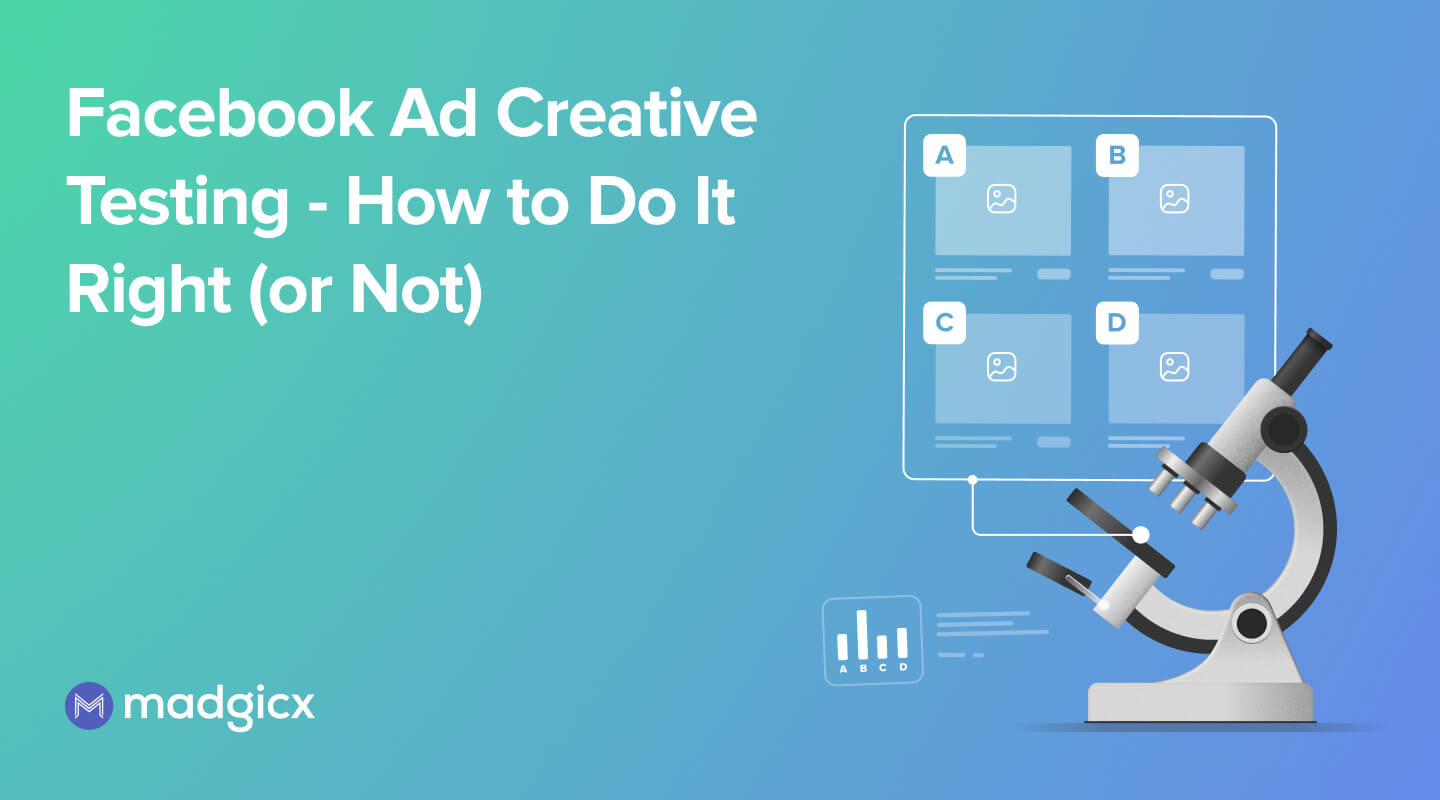



.jpg)
